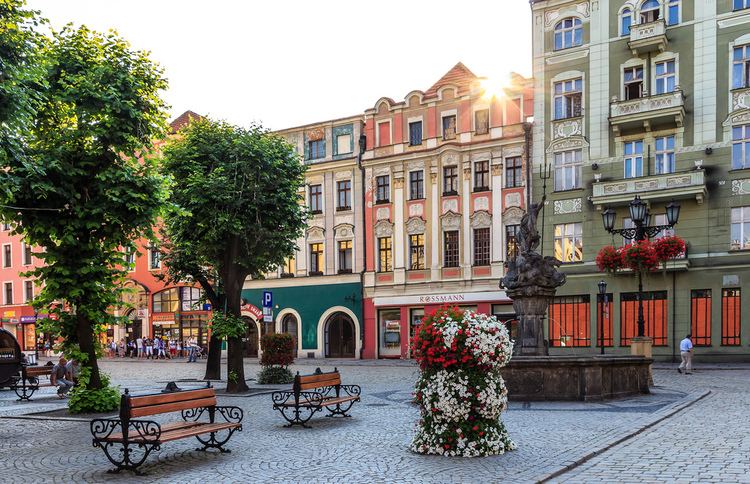Elevation 250 m (820 ft) Area 21.76 km² Local time Sunday 8:27 PM | County Świdnica County City rights 1267 Time zone CET (UTC+1) Population 59,002 (2014) | |
 | ||
Weather 15°C, Wind NW at 11 km/h, 63% Humidity Voivodeship Lower Silesian Voivodeship | ||
widnica poland
Świdnica (['ɕfʲidʲˈɲit͡sa]; German: Schweidnitz; Czech: Svídnice) is a city in southwestern Poland in the region of Silesia. It has a population of 59,002 inhabitants according to 2014 figures. It lies in Lower Silesian Voivodeship, being the seventh largest town in that voivodeship. From 1975–98 it was in the former Wałbrzych Voivodeship. It is now the seat of Świdnica County, and also of the smaller district of Gmina Świdnica (although it is not part of the territory of the latter, as the town forms a separate urban gmina). Świdnica became part of the Wałbrzych agglomeration on 23 January 2014.
Contents
- widnica poland
- Map of Swidnica Poland
- History
- Points of interest
- Wabrzych constituency
- Education
- Sport
- Twin towns Sister cities
- Notable residents
- References
Map of Swidnica, Poland
History
Świdnica/Schweidnitz became a town in 1250, although no founding document has survived that would confirm this fact. In the beginning, the town belonged to the Duchy of Breslau (now Wrocław). By 1290, the town had city walls and six gates, crafts and trade were blossoming, and in 1291-1392 it was the capital of the Duchy of Schweidnitz.
At the end of the 14th century the city was under rule of the Kingdom of Bohemia, and a long period of growth began. The last Polish Piast duke was Bolko II of Świdnica, and after his death in 1368 the duchy was held by his wife until 1392; after her death it was incorporated into Bohemia by Wenceslaus IV, king of Bohemia and later Holy Roman Emperor. In 1493, the town is recorded by Hartmann Schedel in his Nuremberg Chronicle as Schwednitz
In 1526, all of Silesia, including Świdnica, came under the rule of the Habsburg Monarchy. The city was in the surrounding Duchy of Schweidnitz. The Thirty Years' War (1618–48) ravaged the Duchy. Świdnica was annexed by the Kingdom of Prussia during the First Silesian War (1740–42). It was subsequently turned into a fortress by Frederick II of Prussia's army.
It was captured again by Austria in late 1762, during the Third Silesian War, or Seven Years' War, but remained Prussian after the end of the war. Subsequently, it became part of the Prussian-led German Empire in 1871 during the unification of Germany and stayed within Germany until the end of World War II.
After the defeat of Nazi Germany in 1945, the town, like most of Silesia, became part of Poland under border changes promulgated at the Potsdam Conference, and was officially renamed Świdnica. Those members of the German population who had not fled or been killed during the war were subsequently expelled to Germany and replaced with Poles, many of whom had themselves been expelled from Polish areas annexed by the Soviet Union.
Points of interest
The Gothic Church of Ss. Stanislav and Vaclav from the 14th century has the highest tower in Silesia, standing 103 meters tall; it hosts an image of "Our Lady Health of the Sick". That image will be given a coronation, or crowning, on the 100th anniversary (centenary) of the beginning of the apparitions of the Virgin of Fatima at Fatima, Portugal. The ceremony will be presided over by Pope Francis's special envoy, His Eminence, Zenon Cardinal Grocholewski, Cardinal Prefect Emeritus of the Congregation for Catholic Education and Cardinal Prefect Emeritus of the Supreme Tribunal of the Apostolic Signatura.
The Evangelical Church of Peace, a UNESCO Heritage site, was built from 1656–57.
The 16th-century town hall has been renovated numerous times and combines Gothic, Renaissance, and Baroque architectural elements. The Baroque Church of St. Joseph and the Church of St. Christopher are from the same era. One remaining element of the former defensive works is the Chapel of St. Barbara.
Other notable destinations include the old town and the Stary Rynek square, Gola Dzierżoniowska Castle, Medieval town of Niemcza, Cistercian monastery at Henryków and the Wojsławice Arboretum.
Wałbrzych constituency
Members of Parliament (Sejm) elected from Wałbrzych constituency, (Wałbrzych)
Education
Świdnica is home to a College of Data Communications Technology (Wyższa Szkoła Technologii Teleinformatycznych).
In 2003, Świdnica hosted a session of the Warsaw-based International Chapter of the Order of Smile, when a Child Friendship Centre was established. Świdnica was officially titled the "Capital of Children's Dreams".
Sport
Twin towns — Sister cities
Świdnica is twinned with:
